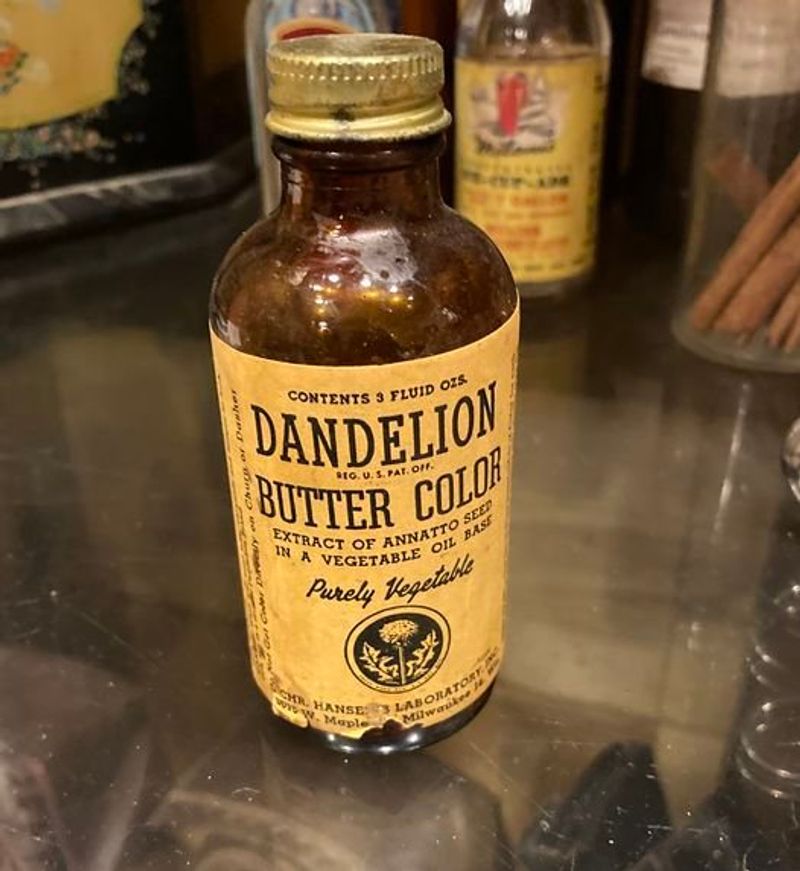- Posts
BUTTER COLORING
Last Updated 12/29/2023
By ESTHER NUNLEY

Original Publish Date: December 27, 2022
A vintage bottle containing a popular marketed 1900s food coloring found in the general store exhibit at the McMinn County Living Heritage Museum contained coloring used in butter and cheese production.
Our small brown bottle holds 3 fluid ounces of Dandelion Butter Color and has a golden colored label. At my first observation I immediately thought of dandelions and wondered how they could produce a coloring for butter. Further reading shows that the color comes from the annatto seed in a vegetable oil base and that the coloring is “purely vegetable.” Everyday uses for coloring cakes, ice cream, and candy are listed on the side of the label.
The annatto seed comes from a small tree or shrub found in Mexico, and Central and South America. The seed is high in tocotrienol, a form of vitamin E, and is rich in antioxidants. Research shows that the seeds are also used to “improve digestion, help manage diabetes, strengthen healthy bones, and reduce signs of aging.”
Color is important in food serving as the cook strives to meet the approval of the receiving eye. Scientist have proven that food tastes better when it looks good! A crafty ad that I found has the headline “Butter Must Look Good—Be Appetizing,” adding that, “’Dandelion Butter Color’ gives Winter Butter that Golden June Shade.” All that is needed is “…one-half teaspoonful to each gallon of cream before churning and out of your churn comes butter of Golden June Shade.” The ad continues to ensure that the coloring is harmless and meets all food laws.
Coloring became very important during the process of milk and cheese when in earlier times it was found that cows did not produce the amount of carotene needed to give the golden color to their milk fat. Only the Guernsey breed was found to have high amounts in their milk fat. The Holstein could yield high amounts while it was eating green grass, otherwise its milk fat is white. The type of feed affected the carotene levels. Cows fed hay during winter produce cream closer to a white color.
Prior to 1907 food colorings were produced from coal tar, a byproduct of coal processing. The process was discovered in 1856 by William Henry Perkin. Those dyes became the first food dyes; however, the FDA took a close look at the dyes releasing standards for food that banned many of those from being used. One of those colors was the golden yellow that was used to color the cheese and butter. Manufacturers turned to producing vegetable-based food coloring.
Our small bottle of Dandelion Butter Color is one of the initial products of a company that is now a global corporation, Chr. Hansen Laboratories. Named for its founder Christian Hansen. The company has been ranked the most sustainable company in the world with its home base in Denmark and branches in France, Germany and the United States. It is a bioscience company producing food cultures, probiotics, enzymes, and human milk oligosaccharides. Examples of oligosaccharides would be lactose, sucrose, and maltose.
Hansen was a native of Denmark. Together he and pharmacist H. P. Madsen founded the company in 1873 with the headquarters located in Denmark and by 1875 they were going global. The company became known as Chr. Hanson Laboratories. During the company’s global expansion, a factory was first opened in New York, later a production plant was opened in Milwaukee, Wisconsin in 1929.
They initially produced products that included animal rennet for cheese making and annatto-based coloring agents. They then branched out producing cultures for cheese, yogurt and sour cream. Hansen was able to avoid the great block the Germans created during World War I that prevented imports to Brittan and beyond by building a manufacturing plant in England during World War I.
When Hansen died in 1916. His son, Johannes took the helm, becoming known as a progressive type manager. The company became a limited liability company and changed its name to Chr. Hansen Laboratorium A/S. It has its presence in over 30 countries and is currently listed as “CHR” on the stock exchange through Nasdaq OMX Copenhagen.

